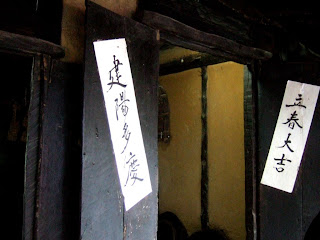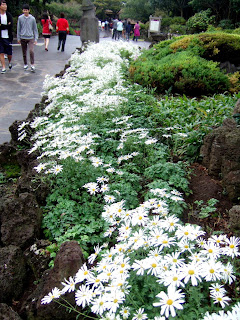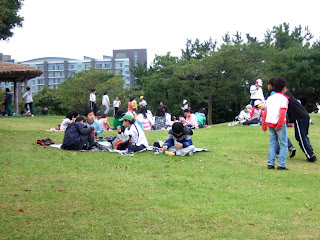The stone statues of faintly smiling stone grandfathers and women with Mul Heobeok hold the very image of Jeju islanders undaunted by their harsh life. Mul Heobeok means water jar. Water has been a precious resource in Jeju Island and Jeju women in those day often had to walk through windy fields for a long time to get water. They used narrow neck and flat bottom Mul Heobeok to avoid water from spilling out and carried the water jar in a basket on their back. By bending over they could easily pour out the water without undo the basket or take out the jar.


Folk Village Museum offers perfectly reproduced images of the 19th century villages on Jeju Island including thatched roof houses, the traditions and different artifacts.



The traditions were recaptured in the hit drama Daejangkeum which featured a woman chef for royal palace during Joseon Dynasty.


The Thatched houses were built low to the ground and the roofs were made of thatch instead of straw and there were woven ropes tightly tied down in a shape of checkerboard across the roof to protect from rain and wind.


To further protect against the frequent rain and wind in the island, the outer walls of all houses were constructed with stones and volcanic clay.



The typical Triple Unit Cottage of 19th century. There were two units of buildings, each had three rooms with shed at corner, across an interval ground, inside the fencing wall.


The outside house of the cottage had no attached kitchen. Rice cleaning area at the center was also a passage. Farmhand stayed on the left room leaving the right space as cowshed.


Chinese calligraphy phrases for luck, longevity, prosperity were pasted onto the doors. Beautiful art items like wooden carving piece were the creation and hand-made products of the artist who quietly carried on his job alone at the small corner he occupied inside the village.



The stone hand-grinder and Dotongsi, Jeju traditional toilet which was surrounded by low stone walls and had no roof, with pigs raised around the place.


Olle, the stone fence, was a long entrance alleyway leading into the main road of a village. It shielded the house from outside view and also kept the grain or crops from blowing away.


Chilli and pumpkin are the most common vegetation within the area and compound.



The history and nature of jeju are under one roof.


Mugunghwa, the pink hibiscus, is the national flower of Korea which means The Rose of Sharon.



Enjoy the flora and fauna of the beautiful garden in the village.


A bush of unknown violet flowers. It was striking and interesting as stock of flowers grow upright as if pointing fingers waving to you.




Some of the thatched houses are occupied by villagers who still prefer the olden way of living.


Clay pots are the most essential storage utensil for Kimchi.


The presence of Dolhareubang, a stone grandfather, was believed to keep away the evil and protect the village.



It took some times to find a way out from this mysterious flora pathway in Maze Garden, as once you enter, you tend to loose direction with its similar layout of flower plants.


Young Korean school children enjoyed outdoor picnic in the park.




Jeju's climate is very ideal for the growth of Tangerines besides pineapples. The oranges of Jeju are famous for its sweetness and thin peel.



No comments:
Post a Comment